SankeyDiagramControl Class
Displays a multilevel Sankey diagram.
Namespace: DevExpress.Xpf.Charts.Sankey
Assembly: DevExpress.Xpf.Charts.v21.2.dll
NuGet Package: DevExpress.Wpf.Charts
Declaration
public class SankeyDiagramControl :
Control,
IWeakEventListener,
IPrintableControl,
IChartsPrintableControl,
ISankeyLayoutOptionsProvider<SankeyNode>Remarks
A Sankey diagram depicts transfers or flows between entities (also called nodes) in a system. This diagram can help locate the most important contributions to a flow.
The following image displays diagram elements:
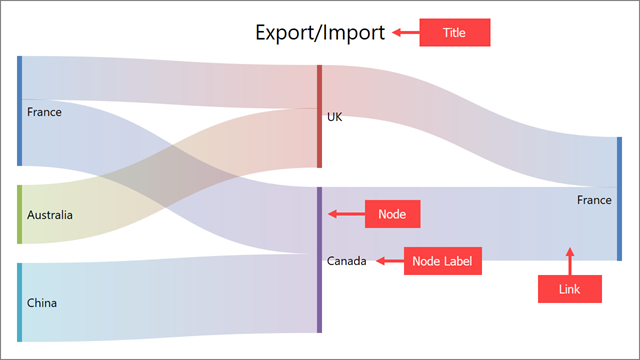
Each link connects the source and target nodes and has an assigned value - weight. The width of a link is proportional to its weight.
Demos
Add to the Project
Drag and drop the SankeyDiagramControl component from the Toolbox to the form to add a Sankey diagram to the project.

This adds references to the following assemblies to the project:
- DevExpress.Charts.v21.2.Core.dll
- DevExpress.Data.v21.2.dll
- DevExpress.DataVisualization.v21.2.Core.dll
- DevExpress.Mvvm.v21.2.dll
- DevExpress.Printing.v21.2.Core.dll
- DevExpress.Xpf.Charts.v21.2.dll
- DevExpress.Xpf.Core.v21.2.dll
- DevExpress.Xpf.Printing.v21.2.dll
Bind to Data
Use the DataSource property to bind the control to a data source. You can assign this property to an object that implements any of the following interfaces: IList, IListSource, or IBindingList.
Then, specify the names of data members that store data for source nodes, target nodes, and weights:
SourceDataMember - Specifies the name of a data member that contains source node labels.
TargetDataMember - Specifies the name of a data member that contains target node labels.
WeightDataMember (Optional) - Specifies the name of a data member that contains link weights. If the WeightDataMember property is not specified, weights are equal to 1.
<Window
xmlns="http://schemas.microsoft.com/winfx/2006/xaml/presentation"
xmlns:x="http://schemas.microsoft.com/winfx/2006/xaml"
xmlns:d="http://schemas.microsoft.com/expression/blend/2008"
xmlns:mc="http://schemas.openxmlformats.org/markup-compatibility/2006"
xmlns:local="clr-namespace:SankeySample"
xmlns:dxsa="http://schemas.devexpress.com/winfx/2008/xaml/sankey"
x:Class="SankeySample.MainWindow"
mc:Ignorable="d"
Title="MainWindow" Height="450" Width="800">
<Grid>
<dxsa:SankeyDiagramControl DataSource="{Binding Data}"
SourceDataMember="Source"
TargetDataMember="Target"
WeightDataMember="Value">
<dxsa:SankeyDiagramControl.DataContext>
<local:SankeyViewModel/>
</dxsa:SankeyDiagramControl.DataContext>
<dxsa:SankeyDiagramControl.Titles>
<dxsa:SankeyTitle Content="Export/Import"
HorizontalAlignment="Center"/>
</dxsa:SankeyDiagramControl.Titles>
</dxsa:SankeyDiagramControl>
</Grid>
</Window>
using System.Collections.Generic;
using System.Windows;
namespace SankeySample {
//...
public class SankeyViewModel {
public List<SankeyItem> Data {
get { return GetData(); }
}
public List<SankeyItem> GetData() {
List<SankeyItem> data = new List<SankeyItem>{
new SankeyItem { Source = "France", Target = "UK", Value = 53 },
new SankeyItem { Source = "Australia", Target = "UK", Value = 72 },
new SankeyItem { Source = "France", Target = "Canada", Value = 81 },
new SankeyItem { Source = "China", Target = "Canada", Value = 96 },
new SankeyItem { Source = "UK", Target = "France", Value = 61 },
new SankeyItem { Source = "Canada", Target = "France", Value = 89 }
};
return data;
}
}
public class SankeyItem {
public string Source { get; set; }
public string Target { get; set; }
public double Value { get; set; }
}
}
Result:
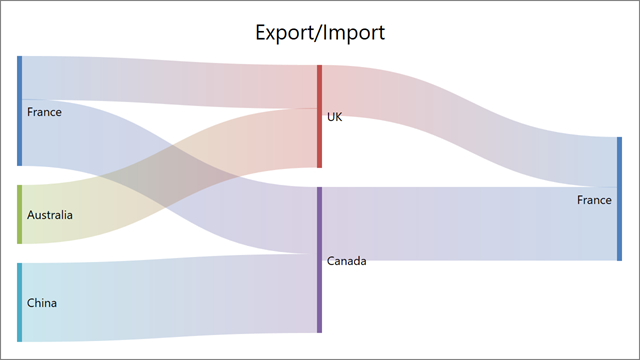
Customize Nodes
Assign a SankeyNodeLabel object to the SankeyDiagramControl.NodeLabel property to specify node label settings such as text orientation:
<dxsa:SankeyDiagramControl>
<!--...-->
<dxsa:SankeyDiagramControl.NodeLabel>
<dxsa:SankeyNodeLabel TextOrientation="BottomToTop"/>
</dxsa:SankeyDiagramControl.NodeLabel>
</dxsa:SankeyDiagramControl>
Initialize the SankeyDiagramControl.NodeTemplate property with a DataTemplate object to customize node label appearance.
<dxsa:SankeyDiagramControl.NodeTemplate>
<DataTemplate>
<Rectangle Stroke="Black"
StrokeThickness="2"
Fill="Transparent"/>
</DataTemplate>
</dxsa:SankeyDiagramControl.NodeTemplate>
For more information about template configuration, refer to the following topic: Data Templating Overview.
Sort Nodes
The control automatically arranges nodes based on underlying data. If you wish to rearrange nodes or specify a custom sort order, create a class that implements IComparer<SankeyNode>. Then, assign an object of this class to the NodeComparer property.
The following code arranges nodes in descending order of their TotalWeight values:
<dxsa:SankeyDiagramControl>
<!--...-->
<dxsa:SankeyDiagramControl.NodeComparer>
<local:MyNodeComparer/>
</dxsa:SankeyDiagramControl.NodeComparer>
<!--...-->
</dxsa:SankeyDiagramControl>
using DevExpress.Xpf.Charts.Sankey;
//...
public class MyNodeComparer : IComparer<SankeyNode> {
public int Compare(SankeyNode x, SankeyNode y) {
return y.TotalWeight.CompareTo(x.TotalWeight);
}
}
Define Node Layout Algorithm
You can use the predefined SankeyLinearLayoutAlgorithm to change node position. The SankeyLinearLayoutAlgorithm.NodeAlignment property specifies the node alignment.
The following example aligns nodes to the top of the Sankey diagram:
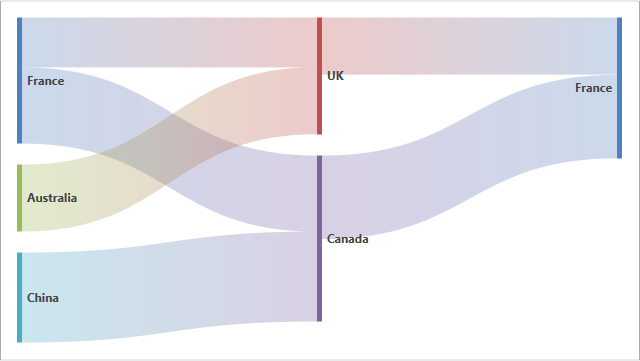
<dxsa:SankeyDiagramControl x:Name="sankeyDiagramControl1" DataSource="{Binding Data}"
SourceDataMember="Source"
TargetDataMember="Target"
WeightDataMember="Value">
<!--...-->
<dxsa:SankeyDiagramControl.LayoutAlgorithm>
<dxsa:SankeyLinearLayoutAlgorithm NodeAlignment="Far"/>
</dxsa:SankeyDiagramControl.LayoutAlgorithm>
</dxsa:SankeyDiagramControl>
You can also implement a custom layout. See the following help topic for more information: SankeyLayoutAlgorithmBase.
Highlight Nodes and Links
The Sankey diagram control highlights a node or a link when the mouse cursor hovers over this element (the default behavior). A node is highlighted with the related links. The image below shows the highlighted Canada node:

Use the EnableHighlighting property to disable highlighting:
<dxsa:SankeyDiagramControl x:Name="sankeyDiagramControl1"
EnableHighlighting="False"
DataSource="{Binding Data}"
SourceDataMember="Source"
TargetDataMember="Target"
WeightDataMember="Value">
<!--...-->
</dxsa:SankeyDiagramControl>
Select Nodes and Links
The SelectionMode property defines whether a user can select links and nodes. Nodes are selected with the related links. The image below shows the selected Canada node:
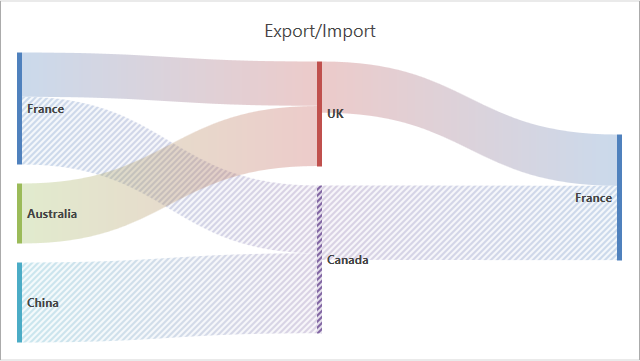
When SelectionMode is None (default), a user cannot select Sankey elements. Set this property to Single, Multiple, or Extended to allow users to select Sankey nodes and links.
The following markup allows a user to select multiple Sankey elements:
<dxsa:SankeyDiagramControl x:Name="sankeyDiagramControl1"
SelectionMode="Multiple"...>
<!--...-->
</dxsa:SankeyDiagramControl>
To select Sankey nodes and links programmatically, add them to the SelectedItems collection. The following example selects the France node and the related links:
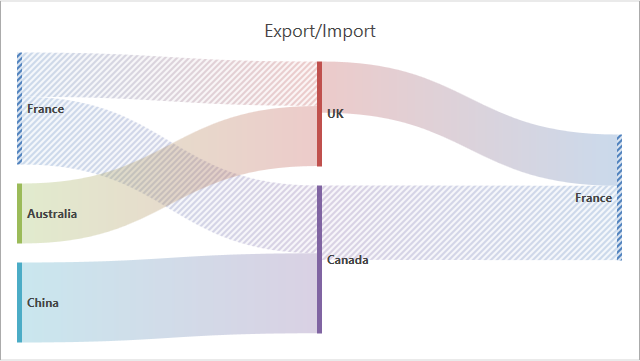
<Window
xmlns="http://schemas.microsoft.com/winfx/2006/xaml/presentation"
xmlns:x="http://schemas.microsoft.com/winfx/2006/xaml"
xmlns:d="http://schemas.microsoft.com/expression/blend/2008"
xmlns:mc="http://schemas.openxmlformats.org/markup-compatibility/2006"
xmlns:local="clr-namespace:WpfApp1"
xmlns:dxsa="http://schemas.devexpress.com/winfx/2008/xaml/sankey"
x:Class="WpfApp1.MainWindow"
mc:Ignorable="d"
Title="MainWindow">
<Grid>
<dxsa:SankeyDiagramControl x:Name="sankeyDiagramControl1"
SelectedItems="{Binding SelectedSankeyItems}" ...>
<!--...-->
<dxsa:SankeyDiagramControl.DataContext>
<local:SankeyViewModel/>
</dxsa:SankeyDiagramControl.DataContext>
</dxsa:SankeyDiagramControl>
</Grid>
</Window>
using System.Collections.Generic;
using System.Collections.ObjectModel;
using System.Collections.Specialized;
using System.ComponentModel;
using System.Windows;
using DevExpress.Xpf.Charts.Sankey;
namespace WpfApp1 {
public partial class MainWindow : Window {
public MainWindow() {
InitializeComponent();
}
}
public class SankeyViewModel : INotifyPropertyChanged {
IList<object> selectedSankeyItems;
List<SankeyItem> data;
public List<SankeyItem> Data {
get {
if (data == null)
data = GetData();
return data;
}
}
public IList<object> SelectedSankeyItems {
get { return selectedSankeyItems; }
set {
if (selectedSankeyItems != value) {
if (selectedSankeyItems is ObservableCollection<object>)
((ObservableCollection<object>)selectedSankeyItems).CollectionChanged -= SelectedSankeyItems_CollectionChanged;
selectedSankeyItems = value;
if (selectedSankeyItems is ObservableCollection<object>)
((ObservableCollection<object>)selectedSankeyItems).CollectionChanged += SelectedSankeyItems_CollectionChanged;
OnPropertyChanged("SelectedSankeyItems");
}
}
}
public SankeyViewModel() {
ObservableCollection<object> collection = new ObservableCollection<object>();
collection.CollectionChanged += SelectedSankeyItems_CollectionChanged;
selectedSankeyItems = collection;
selectedSankeyItems.Add("France");
selectedSankeyItems.Add(Data[0]);
selectedSankeyItems.Add(Data[2]);
selectedSankeyItems.Add(Data[5]);
}
public event PropertyChangedEventHandler PropertyChanged;
void SelectedSankeyItems_CollectionChanged(object sender, NotifyCollectionChangedEventArgs e) {
}
void OnPropertyChanged(string propertyName) {
PropertyChangedEventHandler propertyChangedEventHandler = PropertyChanged;
if (propertyChangedEventHandler != null)
propertyChangedEventHandler(this, new PropertyChangedEventArgs(propertyName));
}
public List<SankeyItem> GetData() {
List<SankeyItem> data = new List<SankeyItem>{
new SankeyItem { Source = "France", Target = "UK", Value = 53 },
new SankeyItem { Source = "Australia", Target = "UK", Value = 72 },
new SankeyItem { Source = "France", Target = "Canada", Value = 81 },
new SankeyItem { Source = "China", Target = "Canada", Value = 96 },
new SankeyItem { Source = "UK", Target = "France", Value = 61 },
new SankeyItem { Source = "Canada", Target = "France", Value = 89 }
};
return data;
}
}
public class SankeyItem {
public string Source { get; set; }
public string Target { get; set; }
public double Value { get; set; }
}
}
For more examples on selection, see the demo:
Specify Node and Link Colors
The Sankey diagram control uses the SankeyPaletteColorizer to color nodes. A new color from the palette is applied to each node with a unique label. Colors repeat if the number of unique labels exceeds the number of palette colors. To apply a gradient fill to links, the control utilizes the source and target node colors. Specify the SankeyPaletteColorizer.Palette property to change colors that are used to paint a Sankey diagram. You can select one of the predefined palettes.

xmlns:dxc="http://schemas.devexpress.com/winfx/2008/xaml/charts"
<!--...-->
<dxsa:SankeyDiagramControl.Colorizer>
<dxsa:SankeyPaletteColorizer LinkBrush="Gray">
<dxsa:SankeyPaletteColorizer.Palette>
<dxc:NorthernLightsPalette/>
</dxsa:SankeyPaletteColorizer.Palette>
</dxsa:SankeyPaletteColorizer>
</dxsa:SankeyDiagramControl.Colorizer>
You can also create a new palette as follows:
xmlns:dxc="http://schemas.devexpress.com/winfx/2008/xaml/charts"
<!--...-->
<dxsa:SankeyDiagramControl.Colorizer>
<dxsa:SankeyPaletteColorizer LinkBrush="Gray">
<dxsa:SankeyPaletteColorizer.Palette>
<dxc:CustomPalette>
<dxc:CustomPalette.Colors>
<Color>Red</Color>
<Color>Green</Color>
<Color>Magenta</Color>
</dxc:CustomPalette.Colors>
</dxc:CustomPalette>
</dxsa:SankeyPaletteColorizer.Palette>
</dxsa:SankeyPaletteColorizer>
</dxsa:SankeyDiagramControl.Colorizer>
Custom Colorizer
Create a class derived from the SankeyColorizerBase class to paint links and nodes based on a custom algorithm. Then, assign an object of this class to the Colorizer property.
The following example implements a colorizer that applies random colors to nodes and specifies colors used to apply a gradient fill to links.

<dxsa:SankeyDiagramControl.Colorizer>
<local:MyColorizer LinkSourceColor="Yellow" LinkTargetColor="Red" />
</dxsa:SankeyDiagramControl.Colorizer>
public class MyColorizer : SankeyColorizerBase {
readonly Random rand = new Random();
readonly Dictionary<string, Color> KeyColorPairs = new Dictionary<string, Color>();
public Color LinkSourceColor { get; set; }
public Color LinkTargetColor { get; set; }
public override Color GetLinkSourceColor(SankeyLink link) {
return LinkSourceColor;
}
public override Color GetLinkTargetColor(SankeyLink link) {
return LinkTargetColor;
}
public override Color GetNodeColor(SankeyNode info) {
if (!KeyColorPairs.TryGetValue((string)info.Tag, out Color nodeColor)) {
nodeColor = GenerateColor();
KeyColorPairs.Add((string)info.Tag, nodeColor);
}
return nodeColor;
}
private Color GenerateColor() {
return Color.FromRgb((byte)rand.Next(256), (byte)rand.Next(256), (byte)rand.Next(256));
}
}
Customize Tooltips
Tooltips are shown when the mouse pointer hovers over a node or link. Use the ToolTipOptions, SankeyToolTipOptions.LinkToolTipEnabled and SankeyToolTipOptions.NodeToolTipEnabled properties to access tooltip settings and disable/enable tooltips.
<dxsa:SankeyDiagramControl>
<dxsa:SankeyDiagramControl.ToolTipOptions>
<dxsa:SankeyToolTipOptions OpenMode="OnHover"
AutoPopDelay="00:00:03"
InitialDelay="00:00:00.1"
CloseOnClick="False"
LinkToolTipEnabled="True"
NodeToolTipEnabled="True"/>
</dxsa:SankeyDiagramControl.ToolTipOptions>
</dxsa:SankeyDiagramControl>
Initialize the SankeyDiagramControl.ToolTipTemplate property with a DataTemplate to customize tooltip appearance.
<dxsa:SankeyDiagramControl.ToolTipTemplate>
<DataTemplate>
<Border BorderThickness="1"
CornerRadius="10"
Opacity="1.0"
Background="#FF2C2B2B">
<StackPanel Orientation="Vertical" Margin="8">
<Label Foreground="White"
FontStyle="Italic"
FontSize="14"
Content="{Binding Path=Info.ToolTipText}" />
</StackPanel>
</Border>
</DataTemplate>
</dxsa:SankeyDiagramControl.ToolTipTemplate>
Print and Export
Use one of the methods below to print the control:
- PrintDirect
- ShowPrintPreview
- ShowPrintPreviewDialog
- ShowRibbonPrintPreview
- ShowRibbonPrintPreviewDialog
The following methods allow you to export the control to various formats:
The code below specifies the resulting Sankey diagram image’s width to fit the document width and exports a Sankey diagram to a PDF file:
sankeyDiagram.PrintOptions = new SankeyPrintOptions {
SizeMode = DevExpress.Xpf.Charts.PrintSizeMode.ProportionalZoom
};
sankeyDiagram.ExportToPdf("D://chart.pdf");